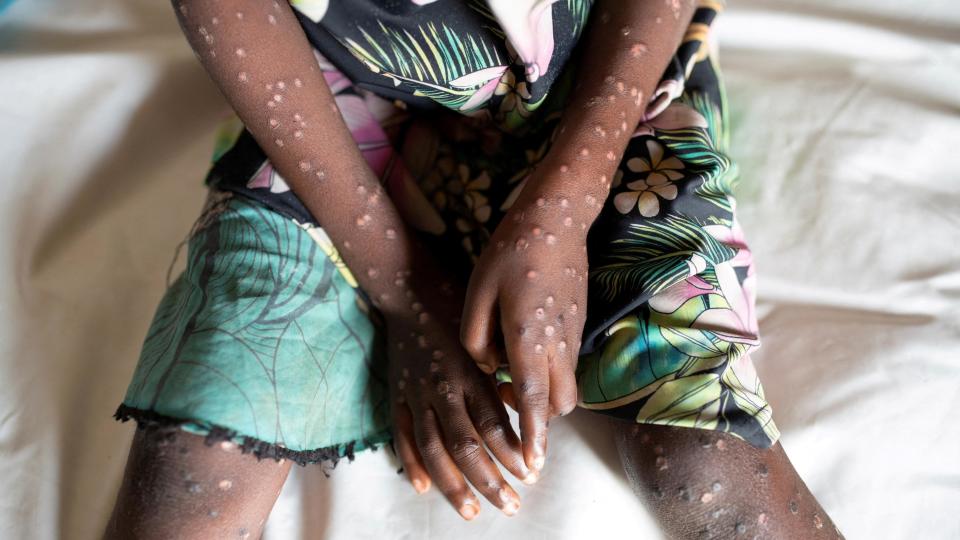New mpox strain in DR Congo 'most dangerous yet'

A new strain of the mpox virus spreading quickly along the eastern border of Democratic Republic of Congo is "incredibly worrying", say health officials monitoring its spread.
The virus, which can cause lesions across the whole body, is making some people very ill and can be deadly.
The current outbreak has been driven by sexual transmission but there is evidence this strain can also be passed on through close skin-to-skin contact.
Global health experts say the new variant risks cross-border and international spread of the virus, with one calling it the "most dangerous strain yet".
A worldwide epidemic of mpox in 2022 was brought under control by vaccinating vulnerable groups.
But there is poor access to vaccines and treatments in DR Congo and local health officials are warning the virus could reach other countries.
"The disease can go through airports. A person with lesions can go through borders because there are no controls," said Leandre Murhula Masirika, at the health department in South Kivu province - one of the worst affected areas in DR Congo.
"I'm very afraid it's going to cause more damage."
'Risk of spread'
Cases of mpox, formerly called monkeypox, have been on the rise in the African country for decades.
Official figures from the World Health Organization (WHO) show there have been nearly 8,000 cases this year in DR Congo, including 384 deaths - almost half of these among children under 15.
An outbreak in South Kivu province, near the border with Rwanda, Burundi and Uganda, is causing particular concern.
Lab testing of virus samples from the area recently found the new mpox strain, which contains mutations that appear to help it circulate among humans.
In the mining town of Kamituga, where the strain is thought to have originated among sex workers in September 2023, cases are rising. Those now being infected include schoolchildren, healthcare workers treating mpox patients and entire households.
The new strain has been detected in several cities along the border, including Goma, which borders Rwanda.
The WHO said it represented "a renewed risk of cross-border and international spread which may potentially lead to an increased risk of severe illness".

Scientists briefing journalists about the current outbreak said they feared the new strain was being spread more easily, causing more serious disease and more deaths in children and adults.
There is also concern over the risk of asymptomatic spread between people who do not have symptoms and are unaware they have the virus.
The current case figures are "the tip of the iceberg", said Prof Trudie Lang, professor of global health research at the University of Oxford.
"It's definitely the most dangerous strain yet.
"We don’t know how many non-severe cases are hidden."
It is also not clear how fast the new strain spreads or whether current vaccines will protect against it. Trials will be needed to work this out, which will take time.
The global outbreak of mpox that spread across Europe and America in 2022 was sexually transmitted and driven by men who have sex with men. It was caused by the Clade II mpox virus.
The new strain is from the more deadly Clade I but is distinct from other outbreaks which have previously affected the region. It can also be spread through non-sexual contact, which makes it more dangerous.
Many children have been infected, including newborn babies during pregnancy.
There have been reports of a small number of infected pregnant women miscarrying their babies.
And some patients have been left with long-term complications with their eyes, skin and genitals.
One healthcare worker looking after an infected patient is reported to have lost her sight after becoming infected herself.
In cases in DR Congo to date, the new strain has a mortality rate of 4% in adults and 10% in children.
Poor access to vaccines
John Claude Udahemuka, a lecturer at the University of Rwanda who is monitoring the eastern DR Congo outbreak, said the first person with the new strain was likely to have been a man who had sex with a woman in Kamituga and then with other women in several different locations.
The disease first appeared in the rainy season when the roads were bad and there was limited movement of people. He warned the current dry season could see more transmission, particularly during school holidays.
The South Kivu health department's Mr Masirika said: "If we can vaccinate sex workers plus health workers, I think cases can be reduced."
African researchers have called for urgent action to improve research into the mpox virus and speed up the distribution of vaccines.
Earlier this month, the WHO said the continuing development of the mpox outbreak in DR Congo was "concerning".
It pointed to limited public awareness of mpox, a lack of treatment kits and vaccines and the country's many other health priorities as factors in the appearance of a new strain.
The risk associated with mpox in DR Congo "remains high", it said.


